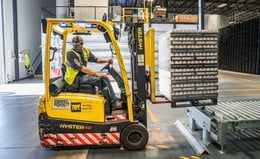What is Every Part Every Interval?
Jesse Kelber - July 23, 2019

Lean manufacturing is a topic of choice these days. Discussions abound on everything from what works and what doesn’t, to how to make what’s not working work for you, to how to implement each individual segment of a lean architecture in a particular niche of the manufacturing world. That’s not our goal today. Instead, we want to cover one specific piece of the lean puzzle—every part every interval, or EPEI. We want to ensure you have a clear picture of this methodology, what it is and isn’t, whether it’s something you should consider implementing at your factory, and, finally, how Industry 4.0 is affecting its place in the value chain. Many of the issues addressed below are applicable to lean manufacturing more widely, so you can take the information presented and apply it to your situation and see how emerging technology might help your bottom line.
EPEI is a framework that aims to reduce excess inventory, shelf time, and order fulfillment time. The overall idea seems simple at first glance: reduce lead time and inventory shelf time by producing runs of different products at the right time, in the right amounts, and in the right order such that you’re able to ship as soon as the items are ready. This eliminates bottlenecks or scheduling gaps where machinery sits idle when it could be producing product, and it keeps that product from sitting on shelves in your warehouse because the order includes items that won’t be produced for some time. In reality, there are many moving parts that have to be orchestrated for a successful implementation of this ideology, but with the emergence of Industry 4.0 technologies, these moving parts are getting easier to manage.
EPEI: The Basics
EPEI is also known by the Japanese term Heijunka, which literally means “leveling.” In this context, it refers to leveling production or inventory. Either way, the basic idea is to bring production capacity, demand, and inventory into sync. Your task here is to break production into lots of whatever size is feasible given your capacity, then produce those lots in repeating cycles to meet demand and keep inventory from stagnating. The time for each lot to be produced is referred to as the interval, which can be anything from a single shift at the factory to an entire quarter. It all depends on your product, demand, etc. IoT sensors distributed throughout the warehouse combined with RFID tracking allow for close monitoring of that inventory.
There are 5 primary elements that need to be accounted for when developing the shortest possible EPEI interval:
- Changeover time: Measuring the time required to change equipment from producing product A to product B, this time can vary from minutes to days. This means it needs to be given equal importance when calculating both production time and production sequence.
- Quantity of units produced: Taking into account everything from order size to demand forecasts and the need for buffer stock, this measurement is key when figuring out your leveling scheme.
- Variety of models produced. Similar to the quantity of units, this measurement is critical to the makeup of your production cycles. Whichever product has the most demand will need to take priority in terms of quantity, and so on.
- Cycle length. This metric refers to the time for each product in the lot to be produced and includes the changeover time to ready the machinery for the next item in the lot.
- Interval length. Measuring the time required for one complete lot to be produced, interval length can vary from one shift all the way up to an entire product lifecycle.
With the goal of evenly distributing production loads over the entire interval, EPEI is a lean manufacturing methodology that has had a great impact on a large number of sectors within the manufacturing world. The arrival of Industry 4.0 technologies like IoT sensors, RFID tags, and digital twins is set to make it more relevant than ever for the modern production facility. Like any production mindset or method, EPEI has its pluses and its minuses. Here, we’ll present a short list of both, along with some ways the technologies mentioned can assist, and leave you to be the judge whether it’s the right direction for your company.
EPEI: The Benefits
On-demand production is a growing segment of today’s manufacturing industry. The ability to keep up with existing orders while making room for these last minute, often unusual, orders is a key to taking your company further into the 21st-century. Load leveling can get you there. By staggering production and leveling out inventory, EPEI provides the flexibility to insert additional production runs of a product while the machinery is set up for that product without needing to retool. Then, production can resume with the next product in the lot, inserting last-minute orders if necessary before continuing on. This efficiency in the production stage means less idle time for stock, quicker order times, and happier customers.
EPEI: The Concerns
Along with the increase in efficiency that EPEI can bring, there are some potential downsides. How accurate is your demand forecasting? If you’re using pen, paper, and intuition then this may not be the option for you. Detailed, data-driven forecasts form the backbone of EPEI and are vital to a successful implementation. What about disruptions on the factory floor? How quickly can you be up and running at full speed when a machine goes down? If you’re not able to respond to downtime quickly, these disruptions can lead to a cascade effect and cause the entire interval to be over time, hurting the entire value chain.
How about materials delivery? Are your suppliers always on time, and are the orders always correct? If not, or if you just don’t know from one order to the next, your intervals can again be disrupted to the point of negating the positive effects of having the interval set up in the first place. And lastly, how’s your buffer stock? Oh, don’t have any? That can derail your EPEI rollout, since without any buffer you aren’t able to fill an order that may have been delayed by any one of the above-mentioned disruptions. How to address these potential points of failure? With Industry 4.0 technologies, of course.
Industry 4.0 Technologies: The Saving Grace of EPEI?
Each of the possible points of failure mentioned above is surmountable if you have the right technology on your side. For example, IoT sensors on your production equipment can alert your maintenance team to a potential breakdown based on historical data about maintenance intervals combined with the recent workload. This allows for proactive maintenance to be carried out during idle time, leading to less unplanned downtime disrupting the lot cycle. And how about that buffer stock? Well, RFID tracking in the warehouse can give you up-to-the-minute stock levels, allowing you to adjust production if necessary while being secure in the knowledge that the next order can be filled. And as for demand forecasting, each of these technologies delivers a constant stream of data for your analysts to use in their predictions, not to mention machine learning and AI, which will soon be able to take over the prediction cycle and provide the most accurate forecasts ever seen. This potent combination of technology and savvy planning means that EPEI is a lean production technique that can help even comparatively volatile manufacturing concerns to thrive.
If you want to learn more get your Guide to Industry 4.0:
LATEST POSTS
- Understand Circular Economy in The Manufacturing Industry
- How Can Industry 4.0 IT Integration Be Achieved Smoothly?
- The Significance of Order Sequencing in Discrete Manufacturing
- How to improve your Supply Chain Management: The Power of Control Towers
- Optimizing Human Resource Scheduling in Manufacturing: A Technological Approach



